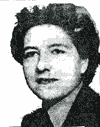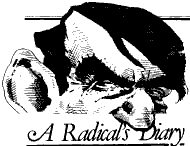|  Tuesday June 27, 2000, Foreign Desk
Vera Atkins, 92, Spymaster for British, Dies By DOUGLAS MARTIN Vera Atkins, who recruited, trained and watched over the legendary British secret agents who parachuted into France to sabotage the Nazis in World War II, died on Saturday in Hastings, Sussex. She was 92.
But Ms. Atkins's steel-trap intelligence and fierce loyalty to agents who had been warned their chances of surviving were barely one in two were a far cry from Miss Moneypenny's lovestruck mooning over the elusive Bond. Ms. Atkins's heart was with her 400 secret agents. She stood on the runway to watch each take off to parachute into France. After the war, when the tally of lost agents turned out to be a little worse than 1 in 4, Ms. Atkins pushed to be assigned to investigate each of the 118 cases. She traced 117, all dead, and brought their surviving killers to war crimes trials. The 118th had been, unknown to her, a compulsive gambler who vanished not far from Monte Carlo while carrying three million francs of secret service money. "I could not just abandon their memory," she said. "I decided we must find out what happened to each one, and where." She spent nearly a year questioning officers from concentration camps and poring over records. "I was probably the only person who could do this," she said. "You had to know every detail of the agents, names, code names, every hair on their heads, to spot their tracks." The confessions she obtained from the Auschwitz commandant, Rudolf Höss, were used as evidence at the Nuremberg Trials. She always shuddered at Höss's reaction to her suggestion that 1.5 million people had been killed in Auschwitz. "Oh no," he said, as if offended. "It was 2,345,000." Ms. Atkins was born Vera Maria Rosenberg in Bucharest, Romania, and went to London with her parents in 1933, where she adopted her mother's last name. She studied modern languages at the Sorbonne and went to finishing school at Lausanne. Her perfect French and her just as perfect manners would come in handy later. At the outbreak of the war, she joined the Special Operations Executive, which Winston Churchill set up "to set Europe ablaze" through sabotage and subversion. The unit started slowly. But after victory in Europe, Dwight D. Eisenhower said, "It was the equivalent of 15 divisions." Hitler said, "When I get to London I am not sure who I shall hang first -- Churchill or that man Buckmaster." Hitler, perhaps, did not know about Buckmaster's assistant, Ms. Atkins. The spymasters headed the unit's F section, for France. They began by interviewing candidates in a hotel room with a desk, two chairs and a lightbulb. After the initial questioning, they had a general conversation in French to see whether the applicant could pass as a native. Each successful candidate was told that he had a 50-50 chance of survival and given a few days to think about it. The recruits were a remarkable cross-section -- bankers and playwrights, chefs and taxicab drivers. Gen. Charles de Gaulle had insisted that the unit not recruit French citizens, while demanding that he control the agents. Most of those selected were half-French British citizens. The initial training was at a 16th-century country house where they had no contact with the outside world. Next came a commando course in the Scottish Highlands, where they learned about guns and explosives. Then there was a survival course in Hampshire, followed by parachute training near Manchester. They were given practice in being interrogated and keeping up their cover stories by going over and over their false identities and backgrounds. It was Ms. Atkins who briefed the agents in minute detail on how to live in occupied France with its curfew and regulations. They were given continental clothing and French mementos, ticket stubs, letters and keepsakes to put in their pockets. At last, they were dropped in France, to be met by reception committees. Each evening, they received their orders in coded personal messages broadcast after the news on the BBC French Service. Ms. Atkins had no rank, but the blunt force of her personality, described by The Times of London as a "sledgehammer," pervaded the operation. She worked 18-hour days. A British television documentary in 1997 reported that she sent off each agent with the brisk shout of a French expletive. One agent, George Millar, recalled in his autobiography, "Road to Resistance,"( Little, Brown, 1980), how she had reacted to his falling in love -- again. "Oh, the bloody English!" she said. "We never have bother of this sort with the French. They just copulate, and that is that." Usually she remained in the shadows. But the accounts of some heroes whom she controlled eventually came to the fore. Four agents were captured separately, given fatal injections and burned in ovens. Violette Szabo, who was tortured and shot, became famous. So did Odette Sansom, who refused to talk even when the Gestapo pulled out her toenails one by one. She was the first woman awarded the George Cross and was the subject of a 1951 movie that took its title from her first name. Ms. Atkins, who did not marry and has no known survivors, worked to keep the memory of the Resistance alive. She was appointed a Commandant of the Legion of Honor in 1987. She traveled a great deal, but settled in a cottage left
her by an aunt at Winchelsea, from which, on a clear day,
you can see France. Related files on this Website: |
On January 21, 1992 The Daily Telegraph revealed that Vera Atkins had been present, as she put it, at the interrogations of Rudolf Höss. I wrote to Miss Atkins asking if I might come and interview her; my interest was natural since several of these vital interrogation documents on Höss are missing, and there is controversy about the degree of force applied to persuade Höss to make the statements that he did (he tried to smuggle a letter out of Nuremberg apologising to his family for having broken under torture and made the statements that he did; see my Nuremberg, the Last Battle). At first she was willing, but to my dismay she then suddenly refused to see me. I was unaware at that time that her real name was Rosenberg, and we must wonder why she changed it to Atkins. There is a small mystery. I disclosed my entire correspondence with Miss Atkins to the defence lawyers in the Lipstadt trial, as it was clearly relevant. They knew of her existence, but made no effort to use her for evidence in the trial. The documents which I disclosed are these
| |
 Although
Ian Fleming never identified her, Ms. Atkins was
widely believed to have inspired the character of Miss
Moneypenny in the James Bond series. She was principal
assistant to Col. Maurice Buckmaster, director of the
Special Operations Executive, who is said to have been the
model for "M."
Although
Ian Fleming never identified her, Ms. Atkins was
widely believed to have inspired the character of Miss
Moneypenny in the James Bond series. She was principal
assistant to Col. Maurice Buckmaster, director of the
Special Operations Executive, who is said to have been the
model for "M." David
Irving writes:
David
Irving writes: